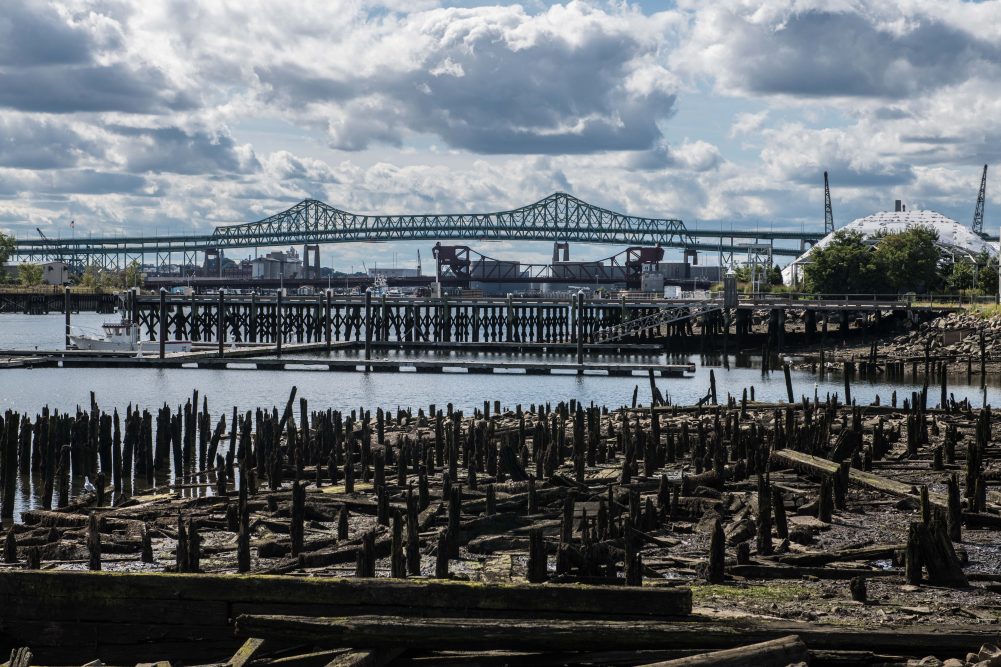The Tobin Bridge spans the Inner Harbor, its northern anchorage and Route 1 bisects Chelsea. Midground Right: One of the salt heaps.
TEXT BY SUREN MOODLIAR
PHOTOS BY DEREK KOUYOUMJIAN (UNLESS OTHERWISE NOTED)
The centuries-long relationship with Boston that made Chelsea a frontline community for environmental justice
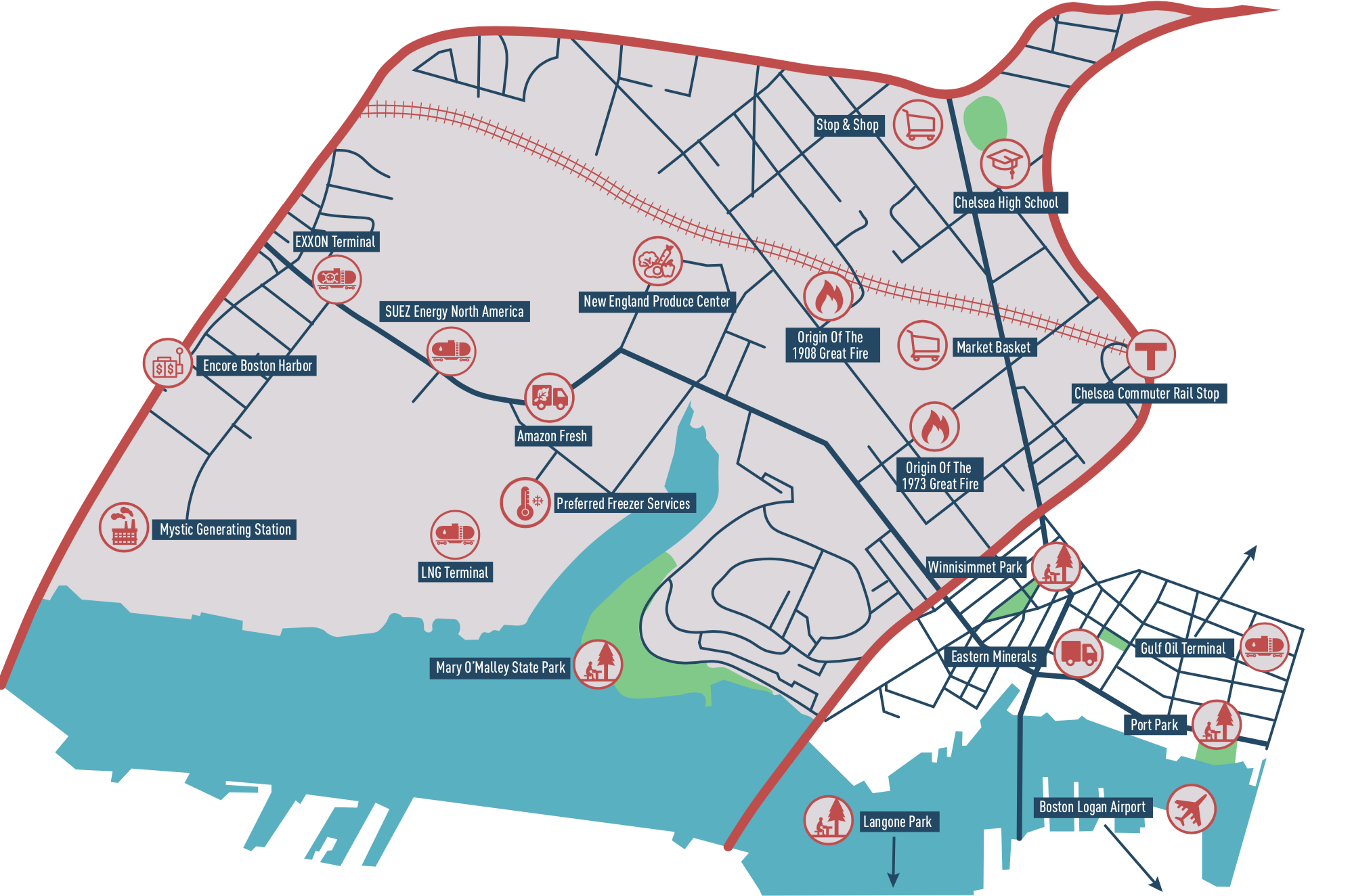
Just north of Boston, a stretch of land barely larger than a square mile, shared between the cities of Chelsea and Everett, is home to a literally explosive corporate matrix of construction, energy, transportation, and food-service infrastructure. This mix itself is surrounded by buildings and transportation routes serving tens of thousands of people every day. There is no safety buffer—unless the adjacent working-class communities are counted as such. Proceeding from one of those communities, the creekside residents of Chelsea, we explore this Square Mile by looking at particular sites and episodes of its history.

In 1631, the year after their occupation of the Shawmut Peninsula began, Boston’s founders established a daily ferry service connecting the settlement to Winnisimmet, present-day Chelsea. Today, spanning Boston’s inner harbor and the Mystic River, the Tobin Bridge has succeeded the ferry. Although, nearly four centuries later, it must be pointed out, the commute time during rush hour and with incessant roadwork likely remains the same. So it is that the two cities have remained linked since their births.
We know less about what came before those births, that is, before colonialism, but those waterways provided the relatively high-speed conduits for vibrant and deeply interconnected federations of indigenous people. In modern-day Chelsea, close to where the Tobin Bridge finds its northern anchorage, the official recognition of its indigenous past remains in the form of a park named Winnisimmet after its original inhabitants. As if guarding against their ghosts, the park is lined on its east side by police SUVs, parked head to tail like circled settler wagons of old, owned by the once-notorious Chelsea Police Department.
Chelsea is still home to this hemisphere’s indigenous people, except that many hail from Latin America and have been forced north by climate change, free-trade policies, and their sequelae. Defining the airspace above them, jets roar overhead, taking off and landing at Boston Logan airport. But the noise and the fumes are but a portion of the desserts served up to Chelsea and neighboring Everett’s residents, and they bear the costs of our fossil fuel-transportation-energy matrix.
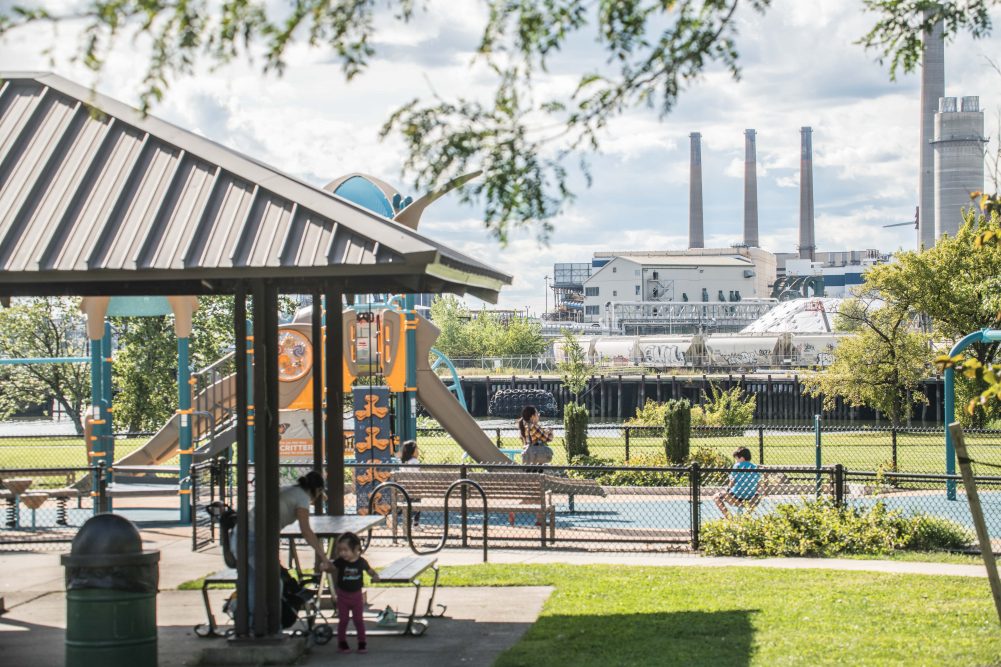
Upon entering the city from East Boston, crossing Chelsea Creek, one is immediately treated to acres of tanks containing aviation fuel or to huge salt heaps, soaring upwards of 50 feet, towering over nearby residences and businesses. The salt is shipped up from Chile, offloaded in Chelsea by a host of diesel-powered machinery, and stored in huge heaps, open to the four winds for half of every year, before massive 18-wheelers cart them off to de-ice our roadways, pikes, and interstates.
The story does not end there: To prevent the salt from absorbing water and forming lumps, a cyanide-based anti-caking agent is used. These are banned for health reasons in Canada; there, other nontoxic de-icing solutions are used. Community resistance, led by organizations like Green Roots, has resulted in some reforms, but it remains true that Chelsea bears the brunt of the associated traffic and the salts remain exposed to the neighborhood.

Following Chelsea Creek, taking the same path as the liquified natural gas-hauling tankers, one comes upon the verdant Mary O’Malley Park that separates the banks from relatively prosperous Admiral’s Hill. In the 1840s, well before the state park came into existence, Elizabeth Cady Stanton, of suffragette fame, nursed her young son on the green, met with legendary abolitionists Frederick Douglass and John Greenleaf Whittier, and picnicked with a view of Boston across the waters. Whitter’s epic poem Snowbound reminded Americans of a bucolic past and an imagined sense of community just as the second industrial revolution was underway. Today, he would be aghast to see, just across from the park, a bewildering hodgepodge of industry: a concrete plant, a refrigeration services operation, and, just behind the plant, one of the largest natural gas (LNG) terminals in the country.
If Whitter gazed north instead, from atop the hill, he would notice Mystic Plaza and Market Basket’s flagship store. Soon after Whitter’s time, however, the same area would have been home to Chelsea’s “Salvage District.” After Boston’s Great Fire of 1872, which began in a commercial warehouse’s basement, new zoning requirements saw industries relocate to the relatively under-regulated Chelsea. By the 1890s, it had become a patchwork of combustible materials of many kinds while employing local immigrant labor, then largely Jewish and Polish. By 1908, it all exploded into a huge conflagration that saw firefighters withdraw in defeat. Ultimately, 19 people died and 15,000 were left homeless. But the city resumed the activities that produced the fire. And, in 1973, the Second Great Chelsea Fire ignited some 200 yards from where the 1908 fire began. This time no lives were lost but more than 1,000 people were displaced and 300 homes lost.
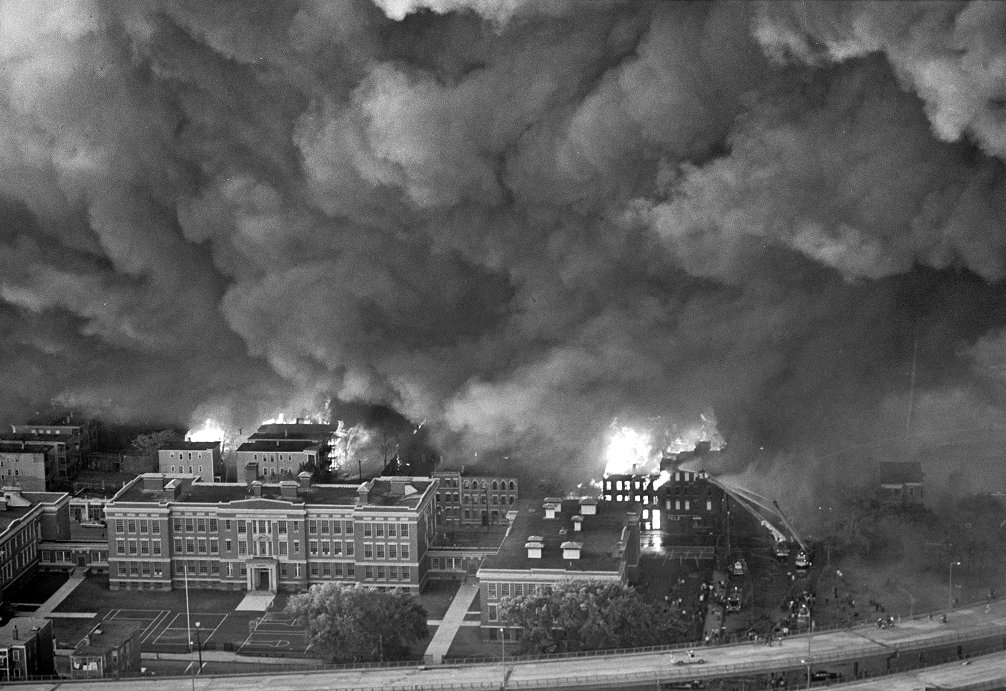
Mystic Plaza is, therefore, a welcome replacement in many senses for the Salvage or “Rag Shop” district. Unlike open malls elsewhere in suburbia, all the modern industries that make possible Mystic Plaza as a node where tens of thousands drive for their grocery needs and services lie within a few hundred yards. There begins the Square Mile, continuing westward toward Encore Boston Harbor, northward to Route 16, and southward, of course, to the Chelsea Creek and the Mystic River.
Although practically at sea level, the Square Mile has no protections against flooding, especially those caused by sea-level rise and storm surges. This fact notwithstanding, ExxonMobil has sited a huge fuel terminal in the heart of the area. The Conservation Law Foundation (CLF) has raised concerns that the facility is routinely polluting the creek with potentially hazardous substances (Polycyclic Aromatic Hydrocarbons, aka PAHs) during its maintenance activities and with rainwater runoff. But it is the potential flooding that raises the most concerns—ExxonMobil seems to have no barriers in place to prevent a storm surge from drowning its facility and spreading its toxic contents all over Everett and Chelsea. The apparent lack of effective preparedness for this eventuality convinced a judge earlier this year to allow CLF’s lawsuit against the megacorporation to proceed.

But ExxonMobil’s site is not the only embodiment of our fossil fuel-dominated society. The aforementioned LNG terminal serves two interstate gas pipelines running through the area as well as an aging natural gas-driven power plant that feeds the regional power grid.
If this concentration of fossil fuel infrastructure makes sense in an era of catastrophic climate change (it shouldn’t), more surprising is that co-mingled with this network of pipes, service roads, wiring, and rail lines is the country’s largest food-processing facility, one drawing in workers and delivery vehicles from all over New England. Amazon Fresh LLC operates a warehouse facility and distribution center serving the area and also its Whole Foods subsidiary if one judges by the truck logos. In addition to the obvious concerns raised by siting food facilities amidst hazardous fossil fuel infrastructure, we must surely be concerned if our daily meals depend on an area with no protection against flooding.

But this is a very incomplete picture unless we consider the critical transportation arteries that convey tens of thousands of commuters every day through or along the square mile; this includes the Newburyport Commuter Rail, Routes 99, 16, and 1, and, at some distance, Route 28 and I-93. Why consider these more removed lines? Because when writing about the most dangerous square mile, one has to borrow the term “blast radius” from demolition and military experts. And, yes, these are all within the blast radius of the LNG plant and the giant fuel tankers that regularly visit it. Back in 2010, Boston Magazine quoted a chemical engineer who observed that with so much fuel, something only need go wrong once. He described it as a “low probability, but high consequence event.” “Low probability” because the LNG would first have to vaporize (warm up) before it became flammable. That’s why the unpredictability of the sequence of events following a storm surge really matters.
And here’s where history comes in, just as it did in 1908 and 1973. Across Boston’s inner harbor and over a quay projecting out from Charlestown, and across the harbor again to where Langone Park wedges itself between the concrete shoreline of the North End and Commercial Streets, like a tuft of grass erupting out of a crack in the pavement… one comes to the site of the infamous molasses tank. There, a hundred years ago, in a frosty January, a molasses tank exploded, a result of its internal fluid dynamics, temperature, and inadequate containment, rivets popped and walls ruptured unleashing a 35-foot wave of molasses that broke across the largely working-class and immigrant community of the North End, its residents then among the lowest paid in the city. It took 21 lives and injured 150 more, prompted a commission of inquiry, the findings of which spoke to corporate neglect and relaxed wartime regulations, leading to reforms in state building codes and increased regulation. An entirely foreseeable disaster could have been averted 100 years ago.
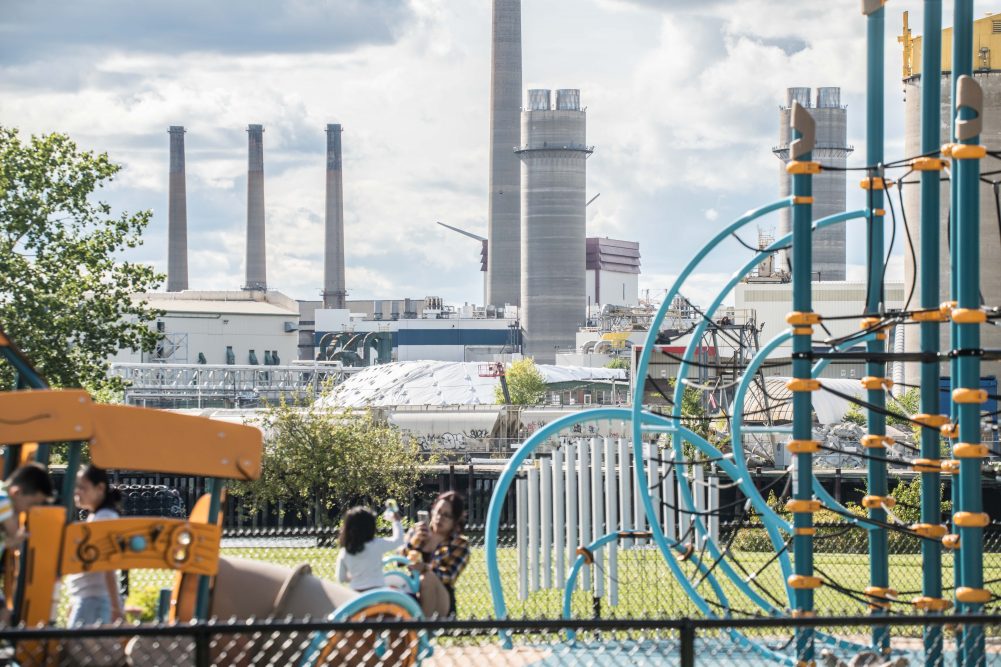
Across Boston Harbor today lies another such largely immigrant working-class community. As Greenland melts, as waters in the tropics warm and fuels storms, the otherwise calm Boston Harbor that gave life and a living to the city will surely swell and surge.
Looking at the Square Mile in light of one very predictable future should not paralyze us. Old forces often in younger guises but nonetheless deeply rooted in American social movement history and in indigenous struggles and worldviews are again stirring to imagine a world in which such hazardous infrastructures and ways of organizing transportation and food are replaced by new relationships between ourselves and with our natures.
 This article is part of the Special Climate Crisis Issue of DigBoston (9/19/2019, Vol. 21, Iss. 38) produced in cooperation with the Boston Institute for Nonprofit Journalism as part of the global Covering Climate Now initiative organized by The Nation and Columbia Journalism Review.
This article is part of the Special Climate Crisis Issue of DigBoston (9/19/2019, Vol. 21, Iss. 38) produced in cooperation with the Boston Institute for Nonprofit Journalism as part of the global Covering Climate Now initiative organized by The Nation and Columbia Journalism Review.


